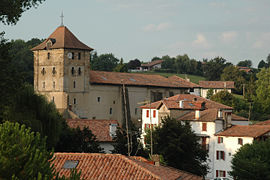Espelette
This article has multiple issues. Please help improve it or discuss these issues on the talk page. (Learn how and when to remove these messages)
|
Espelette
Ezpeleta | |
|---|---|
 The church of Saint-Étienne | |
| Coordinates: 43°20′29″N 1°26′47″W / 43.3414°N 1.4464°W | |
| Country | France |
| Region | Nouvelle-Aquitaine |
| Department | Pyrénées-Atlantiques |
| Arrondissement | Bayonne |
| Canton | Baïgura et Mondarrain |
| Intercommunality | CA Pays Basque |
| Government | |
| • Mayor (2020–2026) | Jean-Marie Iputcha[1] |
Area 1 | 26.85 km2 (10.37 sq mi) |
| Population (2022)[2] | 2,094 |
| • Density | 78/km2 (200/sq mi) |
| Time zone | UTC+01:00 (CET) |
| • Summer (DST) | UTC+02:00 (CEST) |
| INSEE/Postal code | 64213 /64250 |
| Elevation | 33–749 m (108–2,457 ft) (avg. 77 m or 253 ft) |
| 1 French Land Register data, which excludes lakes, ponds, glaciers > 1 km2 (0.386 sq mi or 247 acres) and river estuaries. | |
Espelette (French pronunciation: [ɛspəlɛt]; Basque: Ezpeleta; Occitan: Espeleta) is a commune in the Pyrénées-Atlantiques department in south-western France.[3] It lies in the traditional Basque province of Labourd.
Sights
[edit]The town is attractive, with traditional Labourd houses and a castle. The protected sixteenth-century church, Saint-Etienne, has a Baroque altarpiece, and its graveyard has many traditional Basque discoidal tombstones.
Espelette is a charming town located in Pyrénées-Atlantiques, in the Nouvelle-Aquitaine region of southwestern France. It nestles near the Spanish border in the Navarre region of Spain. It sits approximately 122.4 kilometers from the capital of Pau, and is around 22 kilometers from Bayonne, a significant subprefecture in the region. Notably, Espelette is part of a vibrant community living area of Cambo-les-Bains, placing it in the heart of a dynamic and culturally rich region.
Notable people
[edit]- Agnès Souret, the first woman ever chosen as Miss France, in 1920, is buried in Espelette. She died in Argentina, aged 26, in 1928, and her body was repatriated to Espelette by her mother, who sold most of her possessions to provide a resting place for her daughter.
- Father Armand David (1826–1900), a Lazarist missionary Catholic priest as well as a zoologist and a botanist, was born in Espelette.
Red peppers
[edit]Espelette is known for its dried red peppers, used whole or ground to a hot powder, used in the production of Bayonne ham. The peppers are designated as Appellation d'Origine Contrôlée and are hung to dry outside many of the houses and shops in the village during the summer. The peppers are sold in the town's Wednesday covered market and are honoured in a festival on the last Sunday in October.
See also
[edit]References
[edit]- ^ "Répertoire national des élus: les maires" (in French). data.gouv.fr, Plateforme ouverte des données publiques françaises. 13 September 2022.
- ^ "Populations de référence 2022" (in French). The National Institute of Statistics and Economic Studies. 19 December 2024.
- ^ INSEE commune file
External links
[edit]- (in Spanish) Ezpeleta in the Bernardo Estornés Lasa — Auñamendi Encyclopedia (Euskomedia Fundazioa)
- (in French) Piment d'Espelette, site dedicated to the pepper
-
Traditional Espelette house with peppers drying on the walls
-
Piments d'Espelette, Espelette peppers
-
Plaque of WWF in front of Father Armand David's birth house, inaugurated by Cardinal Roger Etchegaray in Espelette.








